Spatiotemporal Dynamic Evolution of PM2.5 Exposure from Land Use Changes: A Case Study of Gansu Province, China
Abstract
1. Introduction
2. Literature Review
2.1. Land Use Change Studies
2.2. Air Pollution Studies
2.3. Application of Spatial Analysis Techniques
3. Materials and Methods
3.1. Study Area
3.2. Data Source and Processing
3.3. Methods
3.3.1. Land Use Transfer Matrix and Dynamic Degree
3.3.2. PM2.5 Exposure Calculation
3.3.3. Spatial Autocorrelation Analysis
3.3.4. SDE and Center of Gravity Migration Models
4. Experimental Results
4.1. Spatiotemporal Evolution of Land Use Types
4.2. Analysis of PM2.5 PWE for Different Land Use Types
4.2.1. Province Level
4.2.2. City Level
4.2.3. County Level
4.3. Spatial Clustering Patterns of PM2.5 PWE for Different Land Use Types
4.4. SDE and Gravity Center Migration Analysis
5. Discussions
5.1. Land Use Change in Gansu Province
5.2. Multi-Spatial Scale PM2.5 PWE for Different Land Use Types
5.3. Multi-Temporal Scale PM2.5 PWE for Different Land Use Types
5.4. Limitations and Prospects
5.5. Policy Implications
6. Conclusions
Author Contributions
Funding
Data Availability Statement
Acknowledgments
Conflicts of Interest
Appendix A

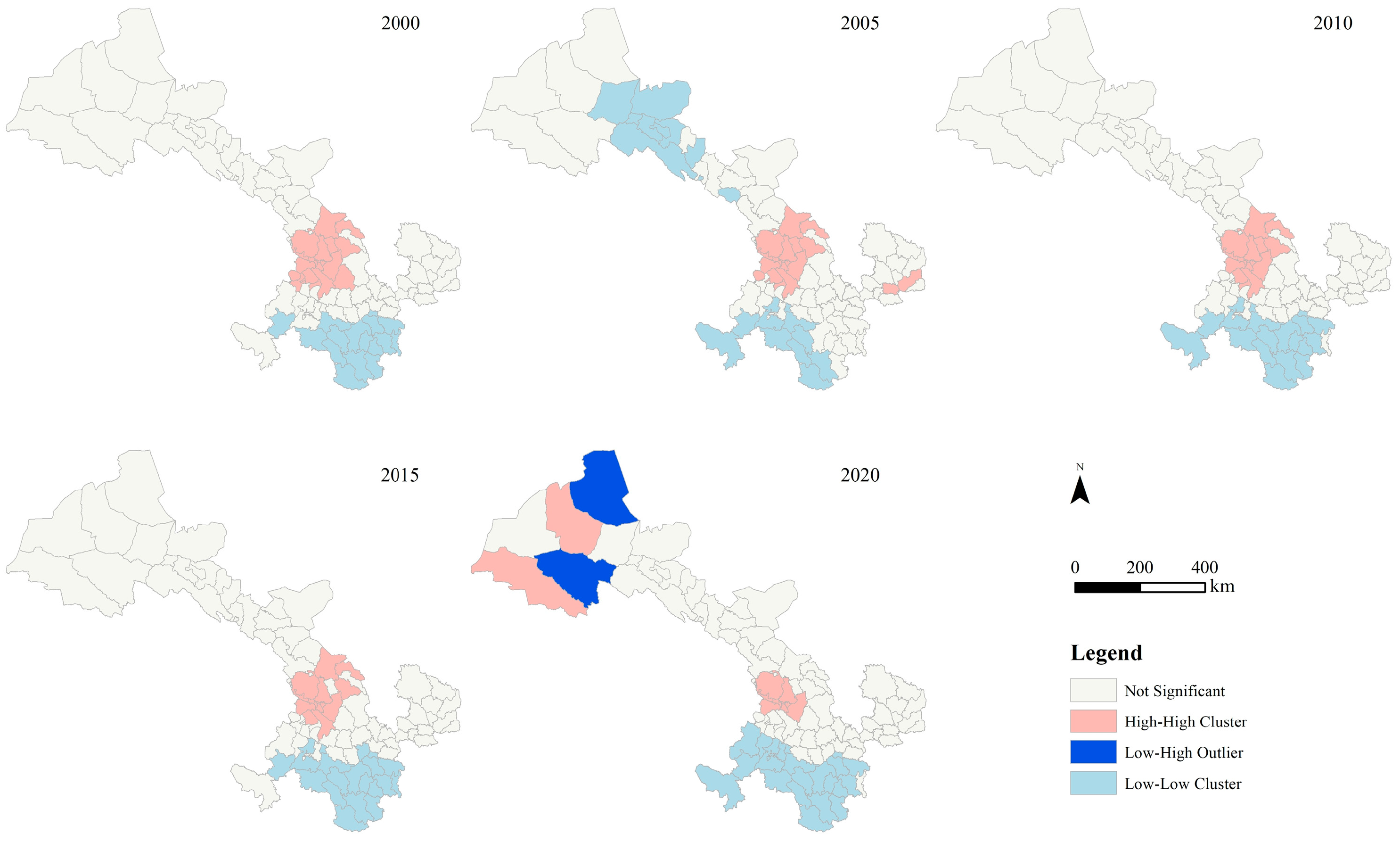
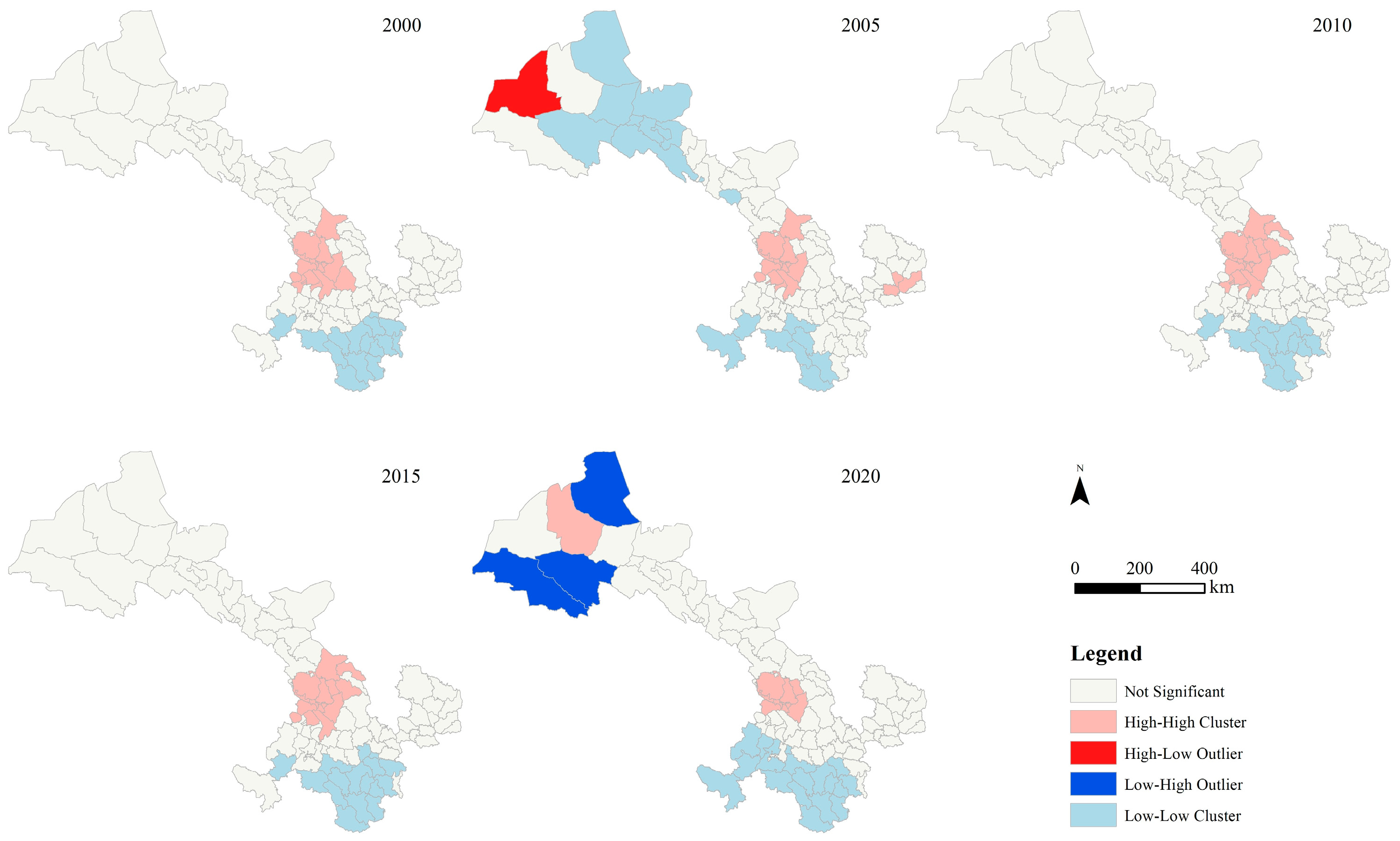
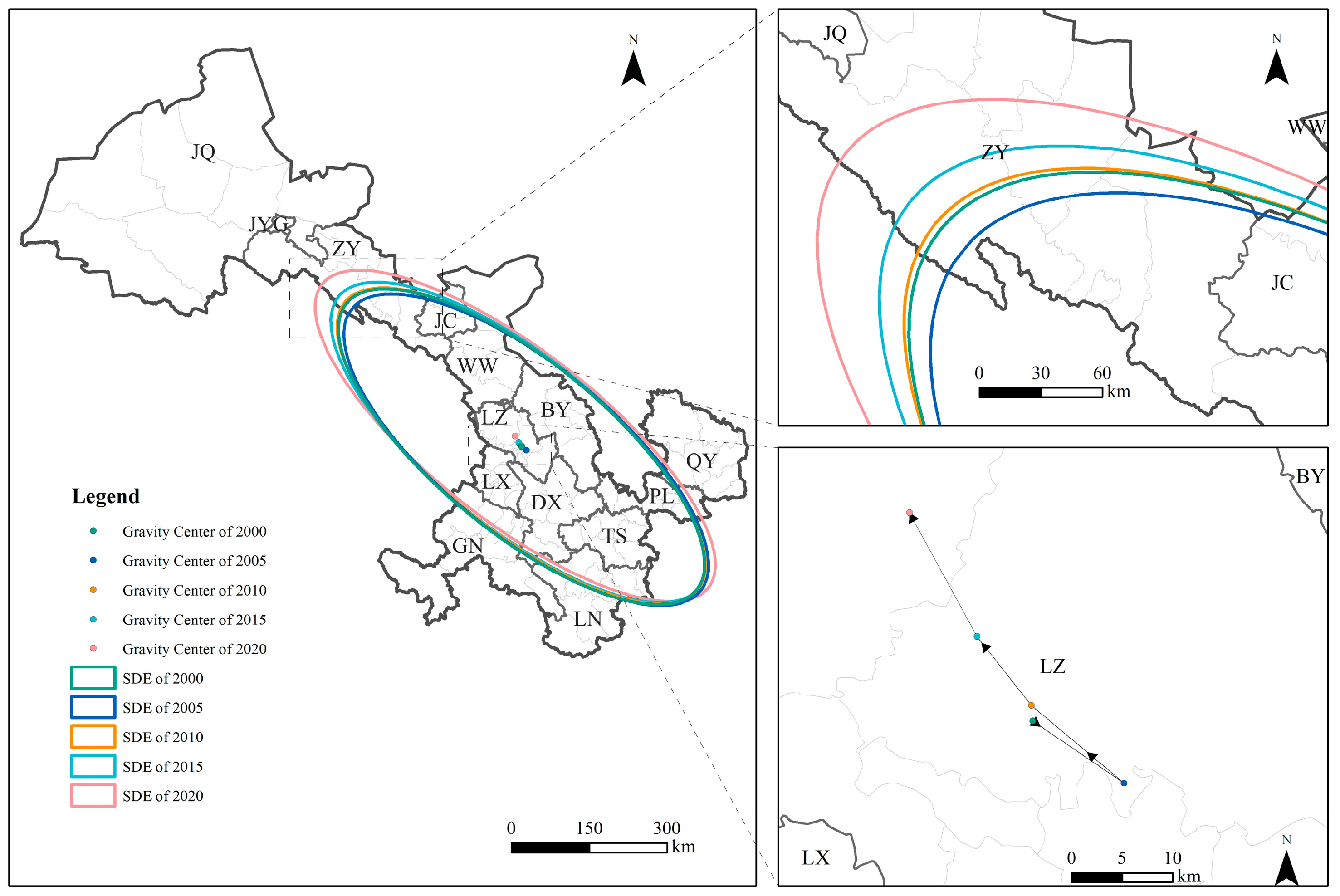

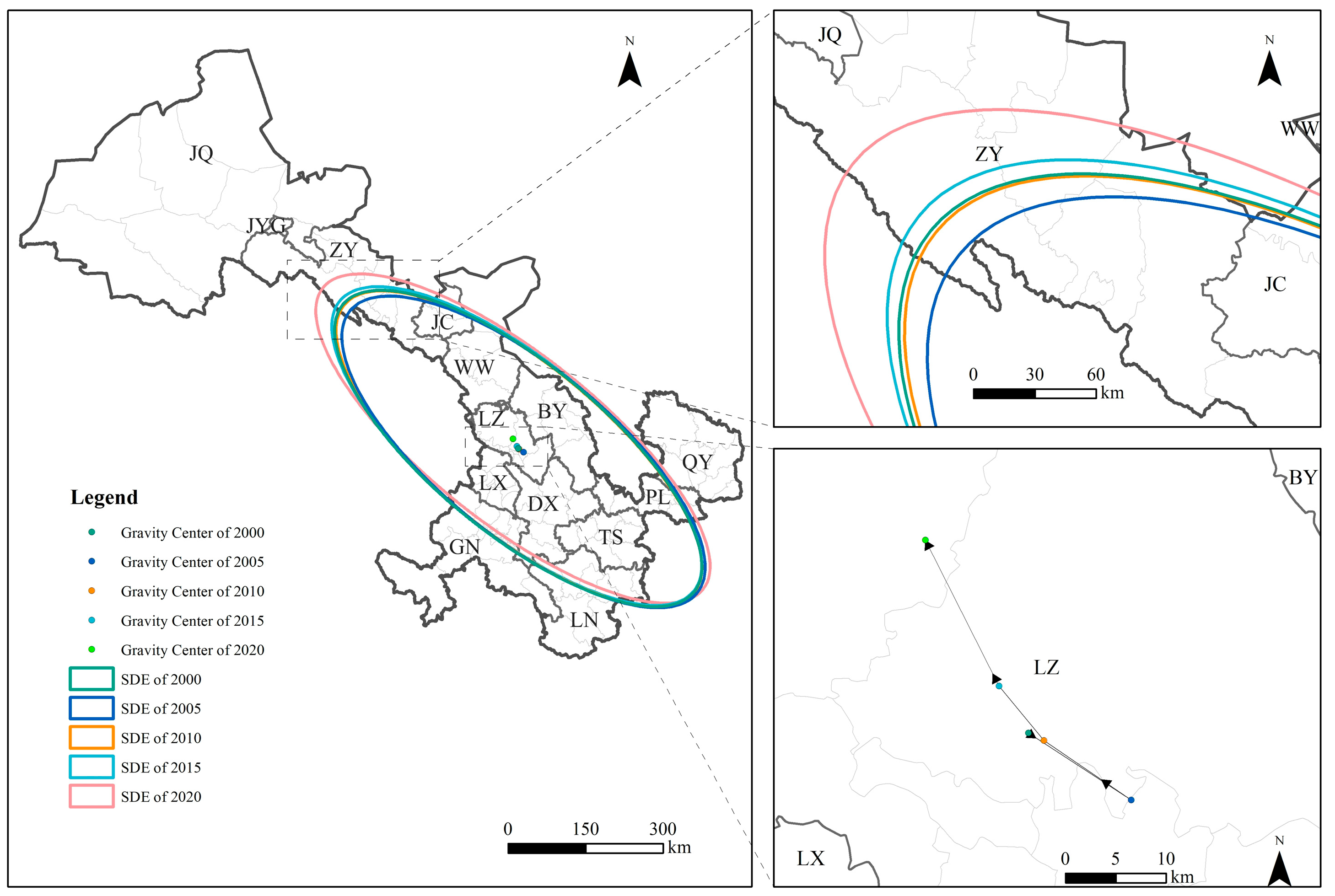
References
- Murray, C.J.L.; Aravkin, A.Y.; Zheng, P.; Abbafati, C.; Abbas, K.M.; Abbasi-Kangevari, M.; Abd-Allah, F.; Abdelalim, A.; Abdollahi, M.; Abdollahpour, I.; et al. Global Burden of 87 Risk Factors in 204 Countries and Territories, 1990–2019: A Systematic Analysis for the Global Burden of Disease Study 2019. Lancet 2020, 396, 1223–1249. [Google Scholar] [CrossRef]
- Brauer, M.; Roth, G.A.; Aravkin, A.Y.; Zheng, P.; Abate, K.H.; Abate, Y.H.; Abbafati, C.; Abbasgholizadeh, R.; Abbasi, M.A.; Abbasian, M.; et al. Global Burden and Strength of Evidence for 88 Risk Factors in 204 Countries and 811 Subnational Locations, 1990–2021: A Systematic Analysis for the Global Burden of Disease Study 2021. Lancet 2024, 403, 2162–2203. [Google Scholar] [CrossRef]
- Health Effects Institute State of Global Air 2024: A Special Report on Global Exposure to Air Pollution and Its Health Impacts, with a Focus on Children’s Health. Available online: https://repository.gheli.harvard.edu/repository/12947/ (accessed on 9 October 2024).
- Dong, J.; Wang, Y.; Wang, L.; Zhao, W.; Huang, C. Assessment of PM2.5 Exposure Risk towards SDG Indicator 11.6.2—A Case Study in Beijing. Sustain. Cities Soc. 2022, 82, 103864. [Google Scholar] [CrossRef]
- Yue, H.; He, C.; Huang, Q.; Zhang, D.; Shi, P.; Moallemi, E.A.; Xu, F.; Yang, Y.; Qi, X.; Ma, Q.; et al. Substantially Reducing Global PM2.5-Related Deaths Under SDG3.9 Requires Better Air Pollution Control and Healthcare. Nat. Commun. 2024, 15, 2729. [Google Scholar] [CrossRef]
- Zheng, H.; Kong, S.; Seo, J.; Yan, Y.; Cheng, Y.; Yao, L.; Wang, Y.; Zhao, T.; Harrison, R.M. Achievements and Challenges in Improving Air Quality in China: Analysis of the Long-Term Trends from 2014 to 2022. Environ. Int. 2024, 183, 108361. [Google Scholar] [CrossRef]
- Yu, W.; Ye, T.; Zhang, Y.; Xu, R.; Lei, Y.; Chen, Z.; Yang, Z.; Zhang, Y.; Song, J.; Yue, X.; et al. Global Estimates of Daily Ambient Fine Particulate Matter Concentrations and Unequal Spatiotemporal Distribution of Population Exposure: A Machine Learning Modelling Study. Lancet Planet. Health 2023, 7, e209–e218. [Google Scholar] [CrossRef]
- He, Q.; Ye, T.; Wang, W.; Luo, M.; Song, Y.; Zhang, M. Spatiotemporally Continuous Estimates of Daily 1-Km PM2.5 Concentrations and Their Long-Term Exposure in China from 2000 to 2020. J. Environ. Manag. 2023, 342, 118145. [Google Scholar] [CrossRef]
- Sun, B.; Fang, C.; Liao, X.; Guo, X.; Liu, Z. The Relationship Between Urbanization and Air Pollution Affected by Intercity Factor Mobility: A Case of the Yangtze River Delta Region. Environ. Impact Assess. Rev. 2023, 100, 107092. [Google Scholar] [CrossRef]
- Lu, X.; Chen, Y.; Huang, Y.; Chen, D.; Shen, J.; Lin, C.; Li, Z.; Fung, J.C.H.; Lau, A.K.H. Exposure and Mortality Apportionment of PM2.5 Between 2006 and 2015 over the Pearl River Delta Region in Southern China. Atmos. Environ. 2020, 231, 117512. [Google Scholar] [CrossRef]
- Ping, L.; Wang, Y.; Lu, Y.; Lee, L.-C.; Liang, C. Tracing the Sources of PM2.5-Related Health Burden in China. Environ. Pollut. 2023, 327, 121544. [Google Scholar] [CrossRef]
- Hu, Y.; Yao, M.; Liu, Y.; Zhao, B. Personal Exposure to Ambient PM2.5, PM10, O3, NO2, and SO2 for Different Populations in 31 Chinese Provinces. Environ. Int. 2020, 144, 106018. [Google Scholar] [CrossRef] [PubMed]
- Lu, D.; Xu, J.; Yue, W.; Mao, W.; Yang, D.; Wang, J. Response of PM2.5 Pollution to Land Use in China. J. Clean. Prod. 2020, 244, 118741. [Google Scholar] [CrossRef]
- Kan, X.; Liu, X.; Zhou, Z.; Zhang, Y.; Zhu, L.; Sian, K.T.C.L.K.; Liu, Q. Analysis of Spatiotemporal Variation and Influencing Factors of PM2.5 in China Based on Multisource Data. Sustainability 2023, 15, 14656. [Google Scholar] [CrossRef]
- Shin, M.; Kang, Y.; Park, S.; Im, J.; Yoo, C.; Quackenbush, L.J. Estimating Ground-Level Particulate Matter Concentrations Using Satellite-Based Data: A Review. GIScience Remote Sens. 2020, 57, 174–189. [Google Scholar] [CrossRef]
- Yin, Z.; Feng, Q.; Zhu, R.; Wang, L.; Chen, Z.; Fang, C.; Lu, R. Analysis and Prediction of the Impact of Land Use/Cover Change on Ecosystem Services Value in Gansu Province, China. Ecol. Indic. 2023, 154, 110868. [Google Scholar] [CrossRef]
- Huang, H.; Jia, J.; Chen, D.; Liu, S. Evolution of Spatial Network Structure for Land-Use Carbon Emissions and Carbon Balance Zoning in Jiangxi Province: A Social Network Analysis Perspective. Ecol. Indic. 2024, 158, 111508. [Google Scholar] [CrossRef]
- Thakrar, S.K.; Johnson, J.A.; Polasky, S. Land-Use Decisions Have Substantial Air Quality Health Effects. Environ. Sci. Technol. 2024, 58, 381–390. [Google Scholar] [CrossRef]
- Liu, J.; Zhang, Z.; Xu, X.; Kuang, W.; Zhou, W.; Zhang, S.; Li, R.; Yan, C.; Yu, D.; Wu, S.; et al. Spatial Patterns and Driving Forces of Land Use Change in China During the Early 21st Century. J. Geogr. Sci. 2010, 20, 483–494. [Google Scholar] [CrossRef]
- Liu, C.; Hu, S.; Wu, S.; Song, J.; Li, H. County-Level Land Use Carbon Emissions in China: Spatiotemporal Patterns and Impact Factors. Sustain. Cities Soc. 2024, 105, 105304. [Google Scholar] [CrossRef]
- Pu, J.; Shen, A.; Liu, C.; Wen, B. Impacts of Ecological Land Fragmentation on Habitat Quality in the Taihu Lake Basin in Jiangsu Province, China. Ecol. Indic. 2024, 158, 111611. [Google Scholar] [CrossRef]
- Gui, D.; He, H.; Liu, C.; Han, S. Spatio-Temporal Dynamic Evolution of Carbon Emissions from Land Use Change in Guangdong Province, China, 2000–2020. Ecol. Indic. 2023, 156, 111131. [Google Scholar] [CrossRef]
- Pan, Y.; Zhang, H.; Wang, C.; Zhou, Y. Impact of Land Use Change on Regional Carbon Sink Capacity: Evidence from Sanmenxia, China. Ecol. Indic. 2023, 156, 111189. [Google Scholar] [CrossRef]
- Shi, Q.; Gu, C.-J.; Xiao, C. Multiple Scenarios Analysis on Land Use Simulation by Coupling Socioeconomic and Ecological Sustainability in Shanghai, China. Sustain. Cities Soc. 2023, 95, 104578. [Google Scholar] [CrossRef]
- Wang, K.; Li, Z.; Xu, Z.; Wang, J.; Jia, M.; Wang, L.; Yue, X.; Duo, X. Evaluating and Simulating the Impacts of Land Use Patterns on Carbon Emissions in Coal Resource-Based Regions: A Case Study of Shanxi Province, China. J. Clean. Prod. 2024, 458, 142494. [Google Scholar] [CrossRef]
- Qi, G.; Wei, W.; Wang, Z.; Wang, Z.; Wei, L. The Spatial-Temporal Evolution Mechanism of PM2.5 Concentration Based on China’s Climate Zoning. J. Environ. Manag. 2023, 325, 116671. [Google Scholar] [CrossRef]
- Li, Y.; Li, B.; Liao, H.; Zhou, B.-B.; Wei, J.; Wang, Y.; Zang, Y.; Yang, Y.; Liu, R.; Wang, X. Changes in PM2.5-Related Health Burden in China’s Poverty and Non-Poverty Areas During 2000–2020: A Health Inequality Perspective. Sci. Total Environ. 2023, 861, 160517. [Google Scholar] [CrossRef]
- Han, C.; Xu, R.; Ye, T.; Xie, Y.; Zhao, Y.; Liu, H.; Yu, W.; Zhang, Y.; Li, S.; Zhang, Z.; et al. Mortality Burden Due to Long-Term Exposure to Ambient PM2.5 above the New WHO Air Quality Guideline Based on 296 Cities in China. Environ. Int. 2022, 166, 107331. [Google Scholar] [CrossRef]
- Lin, C.; Li, Y.; Lau, A.K.H.; Deng, X.; Tse, T.K.T.; Fung, J.C.H.; Li, C.; Li, Z.; Lu, X.; Zhang, X.; et al. Estimation of Long-Term Population Exposure to PM2.5 for Dense Urban Areas Using 1-Km MODIS Data. Remote Sens. Environ. 2016, 179, 13–22. [Google Scholar] [CrossRef]
- Liu, Z.; Xie, M.; Tian, K.; Gao, P. GIS-Based Analysis of Population Exposure to PM2.5 Air Pollution—A Case Study of Beijing. J. Environ. Sci. 2017, 59, 48–53. [Google Scholar] [CrossRef]
- Chen, B.; Lin, Y.; Deng, J.; Li, Z.; Dong, L.; Huang, Y.; Wang, K. Spatiotemporal Dynamics and Exposure Analysis of Daily PM2.5 Using a Remote Sensing-Based Machine Learning Model and Multi-Time Meteorological Parameters. Atmos. Pollut. Res. 2021, 12, 23–31. [Google Scholar] [CrossRef]
- Liu, M.; Saari, R.K.; Zhou, G.; Li, J.; Han, L.; Liu, X. Recent Trends in Premature Mortality and Health Disparities Attributable to Ambient PM2.5 Exposure in China: 2005–2017. Environ. Pollut. 2021, 279, 116882. [Google Scholar] [CrossRef] [PubMed]
- Liu, C.; Chen, R.; Sera, F.; Vicedo-Cabrera, A.M.; Guo, Y.; Tong, S.; Coelho, M.S.Z.S.; Saldiva, P.H.N.; Lavigne, E.; Matus, P.; et al. Ambient Particulate Air Pollution and Daily Mortality in 652 Cities. N. Engl. J. Med. 2019, 381, 705–715. [Google Scholar] [CrossRef] [PubMed]
- Zhang, Y.; Ma, R.; Ban, J.; Lu, F.; Guo, M.; Zhong, Y.; Jiang, N.; Chen, C.; Li, T.; Shi, X. Risk of Cardiovascular Hospital Admission After Exposure to Fine Particulate Pollution. J. Am. Coll. Cardiol. 2021, 78, 1015–1024. [Google Scholar] [CrossRef] [PubMed]
- Tallis, M.; Taylor, G.; Sinnett, D.; Freer-Smith, P. Estimating the Removal of Atmospheric Particulate Pollution by the Urban Tree Canopy of London, Under Current and Future Environments. Landsc. Urban Plan. 2011, 103, 129–138. [Google Scholar] [CrossRef]
- Wang, P.; Zeng, C.; Zhang, W.; Lv, T.; Miao, X.; Xiang, H. Investigation of the Spatial Effects on PM2.5 in Relation to Land Use and Ecological Restoration in Urban Agglomerations. Sci. Total Environ. 2024, 913, 169665. [Google Scholar] [CrossRef]
- Chen, M.; Dai, F.; Yang, B.; Zhu, S. Effects of Neighborhood Green Space on PM2.5 Mitigation: Evidence from Five Megacities in China. Build. Environ. 2019, 156, 33–45. [Google Scholar] [CrossRef]
- Zhao, H.; Tong, D.Q.; Gao, C.; Wang, G. Effect of Dramatic Land Use Change on Gaseous Pollutant Emissions from Biomass Burning in Northeastern China. Atmos. Res. 2015, 153, 429–436. [Google Scholar] [CrossRef]
- Wang, Y.; Wang, M.; Wu, Y.; Sun, G. Exploring the Effect of Ecological Land Structure on PM2.5: A Panel Data Study Based on 277 Prefecture-Level Cities in China. Environ. Int. 2023, 174, 107889. [Google Scholar] [CrossRef]
- Guan, Q.; Liu, Z.; Yang, L.; Luo, H.; Yang, Y.; Zhao, R.; Wang, F. Variation in PM2.5 Source over Megacities on the Ancient Silk Road, Northwestern China. J. Clean. Prod. 2019, 208, 897–903. [Google Scholar] [CrossRef]
- Huang, J.; Li, X.; Zhang, Y.; Zhai, S.; Wang, W.; Zhang, T.; Yin, F.; Ma, Y. Socio-Demographic Characteristics and Inequality in Exposure to PM2.5: A Case Study in the Sichuan Basin, China. Environ. Pollut. 2023, 316, 120630. [Google Scholar] [CrossRef]
- Chen, L.; Shi, M.; Gao, S.; Li, S.; Mao, J.; Zhang, H.; Sun, Y.; Bai, Z.; Wang, Z. Assessment of Population Exposure to PM2.5 for Mortality in China and Its Public Health Benefit Based on BenMAP. Environ. Pollut. 2017, 221, 311–317. [Google Scholar] [CrossRef] [PubMed]
- Liu, M.; Wang, Y.; Liu, R.; Ding, C.; Zhou, G.; Han, L. How Magnitude of PM2.5 Exposure Disparities Have Evolved across Chinese Urban-Rural Population During 2010–2019. J. Clean. Prod. 2023, 382, 135333. [Google Scholar] [CrossRef]
- Bai, Y.; Liu, M. Multi-Scale Spatiotemporal Trends and Corresponding Disparities of PM2.5 Exposure in China. Environ. Pollut. 2024, 340, 122857. [Google Scholar] [CrossRef] [PubMed]
- Wei, J.; Li, Z.; Cribb, M.; Huang, W.; Xue, W.; Sun, L.; Guo, J.; Peng, Y.; Li, J.; Lyapustin, A.; et al. Improved 1km Resolution PM2.5 Estimates across China Using Enhanced Space–Time Extremely Randomized Trees. Atmos. Chem. Phys. 2020, 20, 3273–3289. [Google Scholar] [CrossRef]
- Wei, J.; Li, Z.; Lyapustin, A.; Sun, L.; Peng, Y.; Xue, W.; Su, T.; Cribb, M. Reconstructing 1-Km-Resolution High-Quality PM2.5 Data Records from 2000 to 2018 in China: Spatiotemporal Variations and Policy Implications. Remote Sens. Environ. 2021, 252, 112136. [Google Scholar] [CrossRef]
- Wei, J.; Li, Z. ChinaHighPM2.5: High-Resolution and High-Quality Ground-Level PM2.5 Dataset for China (2000–2023); National Tibetan Plateau/Third Pole Environment Data Center: Beijing, China, 2023. [Google Scholar] [CrossRef]
- Kyaw, A.K.; Hamed, M.M.; Kamruzzaman, M.; Shahid, S. Spatiotemporal Changes in Population Exposure to Heat Stress in South Asia. Sustain. Cities Soc. 2023, 93, 104544. [Google Scholar] [CrossRef]
- Zhu, L.; Fang, J.; Yao, Y.; Yang, Z.; Wu, J.; Ma, Z.; Liu, R.; Zhan, Y.; Ding, Z.; Zhang, Y. Long-Term Ambient Ozone Exposure and Incident Cardiovascular Diseases: National Cohort Evidence in China. J. Hazard. Mater. 2024, 471, 134158. [Google Scholar] [CrossRef]
- Liu, Z.; Li, J.; Chen, H.; Wang, L.; Yang, J.; Plaza, A. Prediction of Changes in War-Induced Population and CO2 Emissions in Ukraine Using Social Media. Humanit. Soc. Sci. Commun. 2024, 11, 884. [Google Scholar] [CrossRef]
- Basu, T.; Das, A. Urbanization Induced Changes in Land Use Dynamics and Its Nexus to Ecosystem Service Values: A Spatiotemporal Investigation to Promote Sustainable Urban Growth. Land Use Policy 2024, 144, 107239. [Google Scholar] [CrossRef]
- Tessum, C.W.; Paolella, D.A.; Chambliss, S.E.; Apte, J.S.; Hill, J.D.; Marshall, J.D. PM2.5 Polluters Disproportionately and Systemically Affect People of Color in the United States. Sci. Adv. 2021, 7, eabf4491. [Google Scholar] [CrossRef]
- Getis, A.; Ord, J.K. The Analysis of Spatial Association by Use of Distance Statistics. Geogr. Anal. 1992, 24, 189–206. [Google Scholar] [CrossRef]
- Anselin, L. Local Indicators of Spatial Association—LISA. Geogr. Anal. 1995, 27, 93–115. [Google Scholar] [CrossRef]
- Chen, D.; Guo, Y.; Zhao, Y.; Zhang, J.; Liu, X.; Tong, Z.; Zhao, C. Dynamic Evolution Characteristics and Hazard Assessment of Compound Drought/Waterlogging and Low Temperature Events for Maize. Sci. Total Environ. 2024, 946, 174427. [Google Scholar] [CrossRef] [PubMed]
- Liang, L.; Chen, M.; Luo, X.; Xian, Y. Changes Pattern in the Population and Economic Gravity Centers since the Reform and Opening up in China: The Widening Gaps between the South and North. J. Clean. Prod. 2021, 310, 127379. [Google Scholar] [CrossRef]
- Chen, Y. Spatial Autocorrelation Equation Based on Moran’s Index. Sci. Rep. 2023, 13, 19296. [Google Scholar] [CrossRef]
- Qiao, F. Research on Driving Mechanism and Prediction of Electric Power Carbon Emission in Gansu Province Under Dual-Carbon Target. Sci. Rep. 2024, 14, 6103. [Google Scholar]
- Zhou, X.; Gao, X.; Chang, Y.; Zhao, S.; Li, P. The Pattern and Mechanism of an Unhealthy Air Pollution Event in Lanzhou, China. Urban Clim. 2023, 48, 101409. [Google Scholar] [CrossRef]
- Guan, Q.; Cai, A.; Wang, F.; Yang, L.; Xu, C.; Liu, Z. Spatio-Temporal Variability of Particulate Matter in the Key Part of Gansu Province, Western China. Environ. Pollut. 2017, 230, 189–198. [Google Scholar] [CrossRef]
- Wang, Y.Q.; Zhang, X.Y.; Sun, J.Y.; Zhang, X.C.; Che, H.Z.; Li, Y. Spatial and Temporal Variations of the Concentrations of PM10, PM2.5 and PM1 in China. Atmos. Chem. Phys. 2015, 15, 13585–13598. [Google Scholar] [CrossRef]
- Xu, W.; Zhao, Y.; Wen, Z.; Chang, Y.; Pan, Y.; Sun, Y.; Ma, X.; Sha, Z.; Li, Z.; Kang, J.; et al. Increasing Importance of Ammonia Emission Abatement in PM2.5 Pollution Control. Sci. Bull. 2022, 67, 1745–1749. [Google Scholar] [CrossRef]


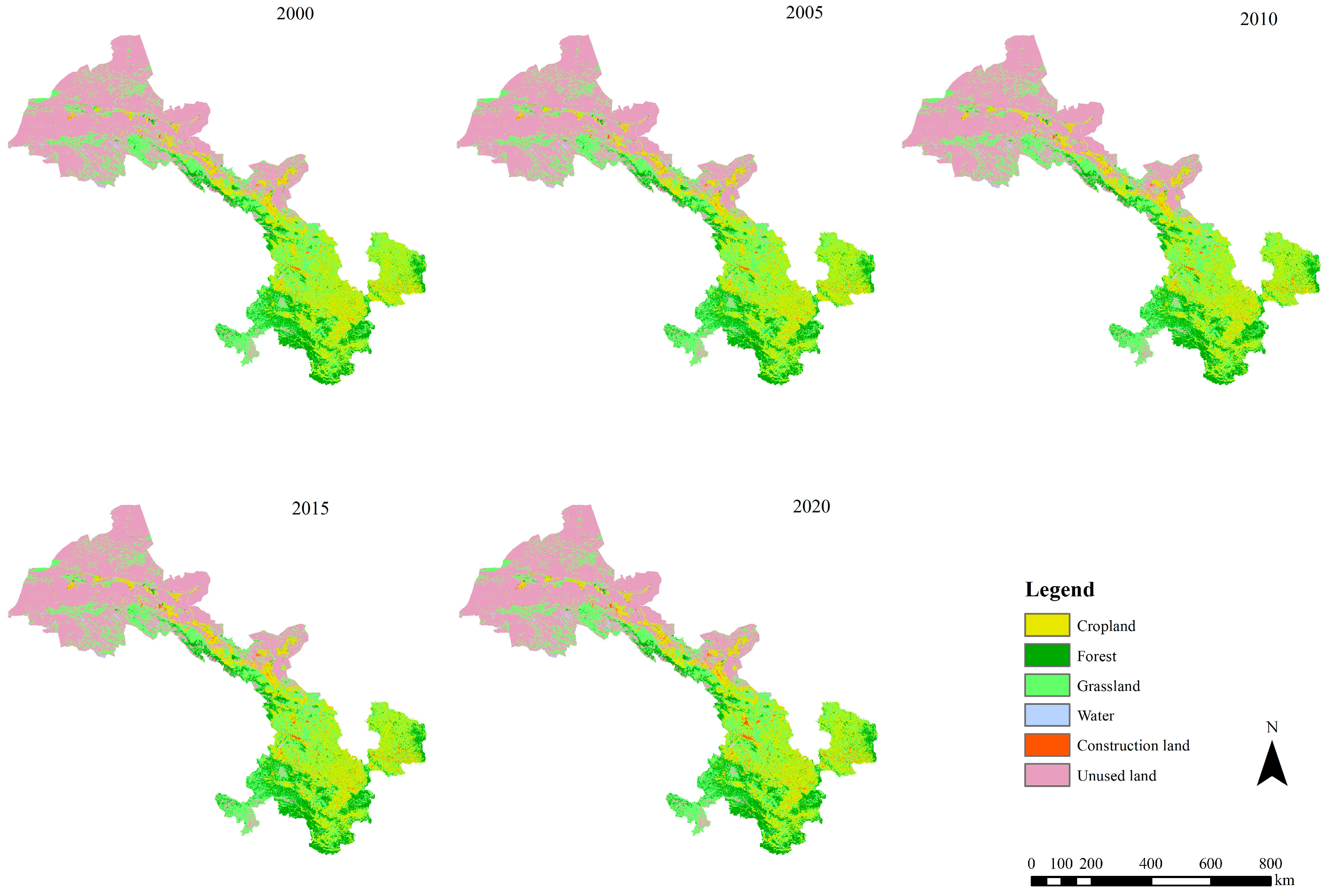

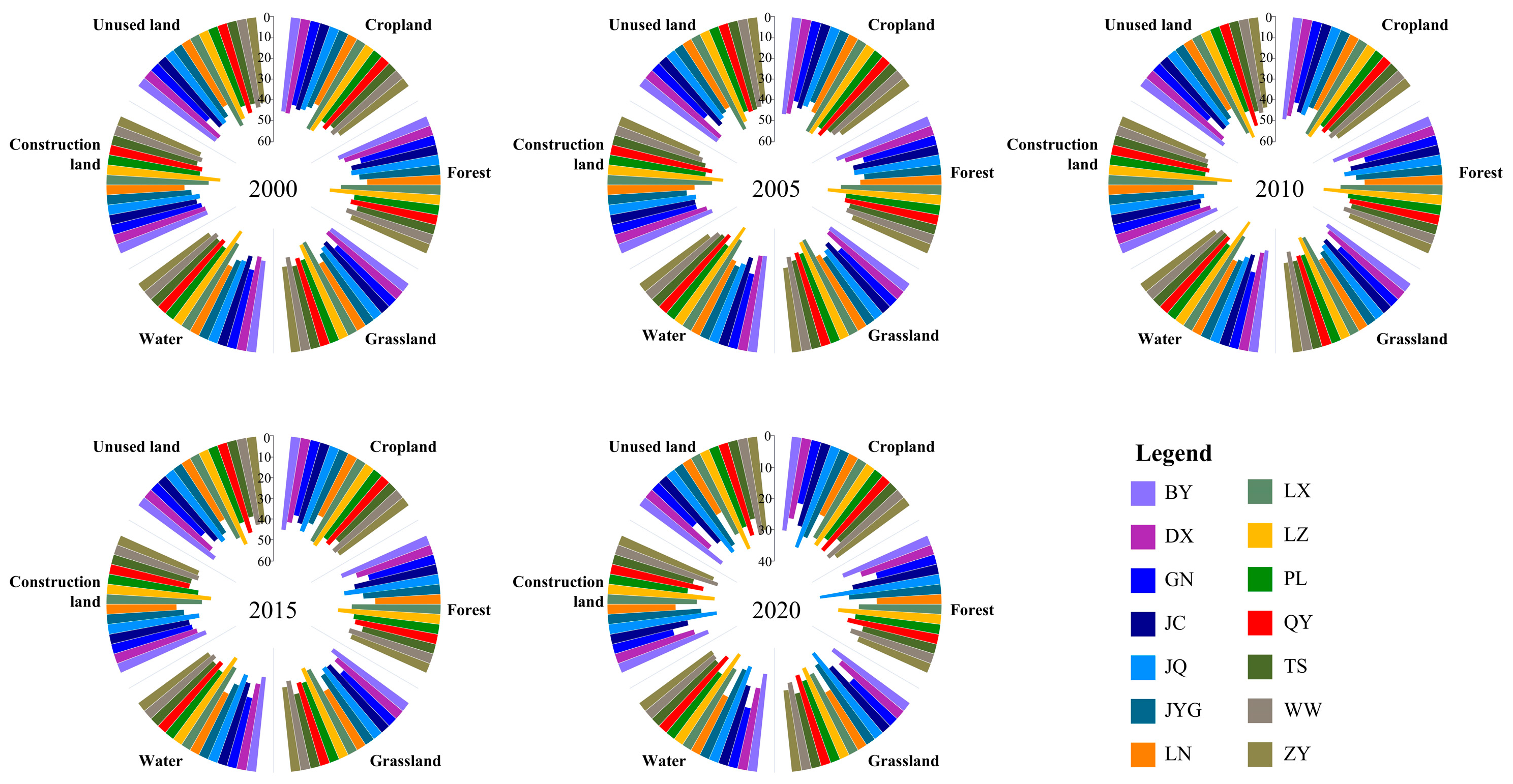

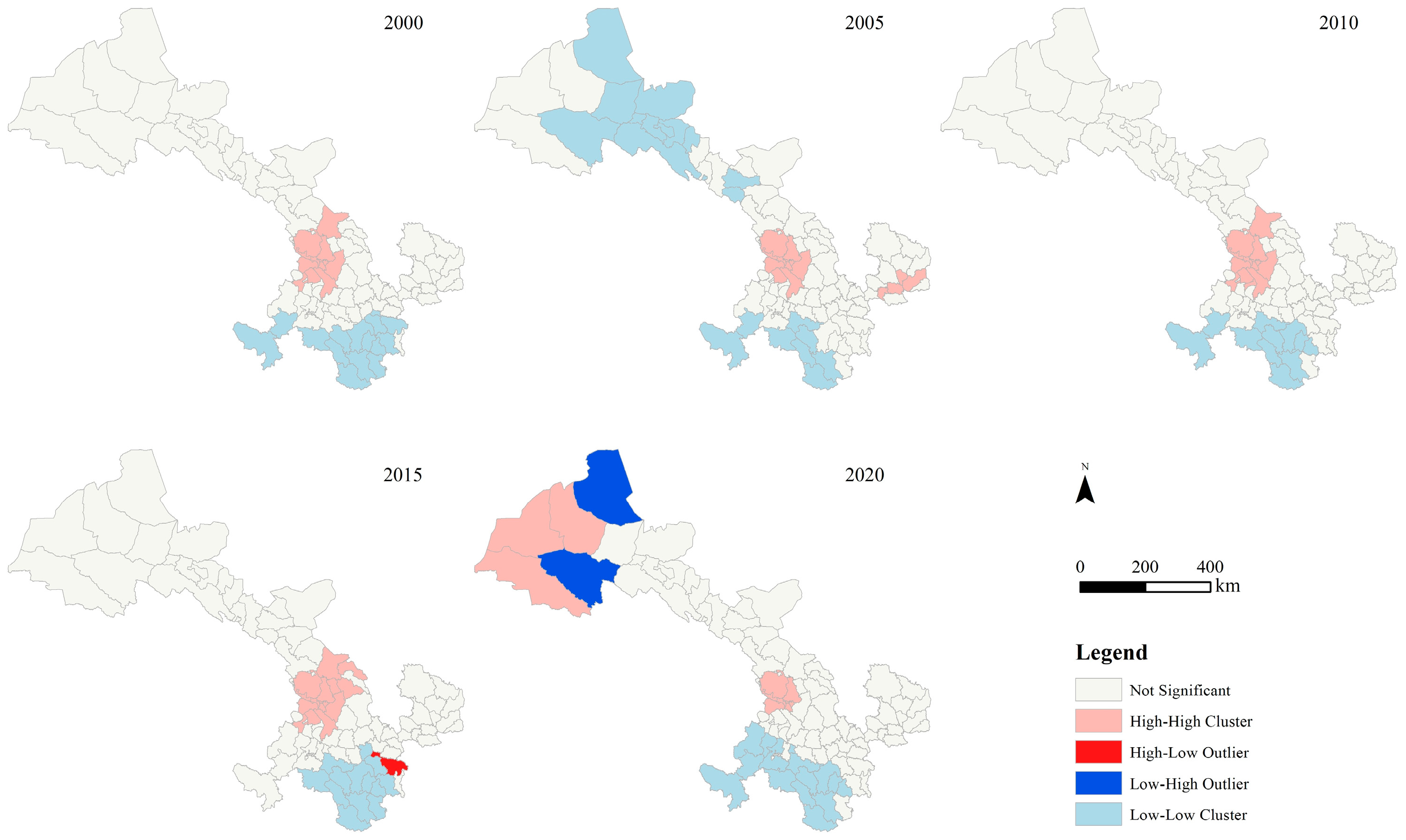
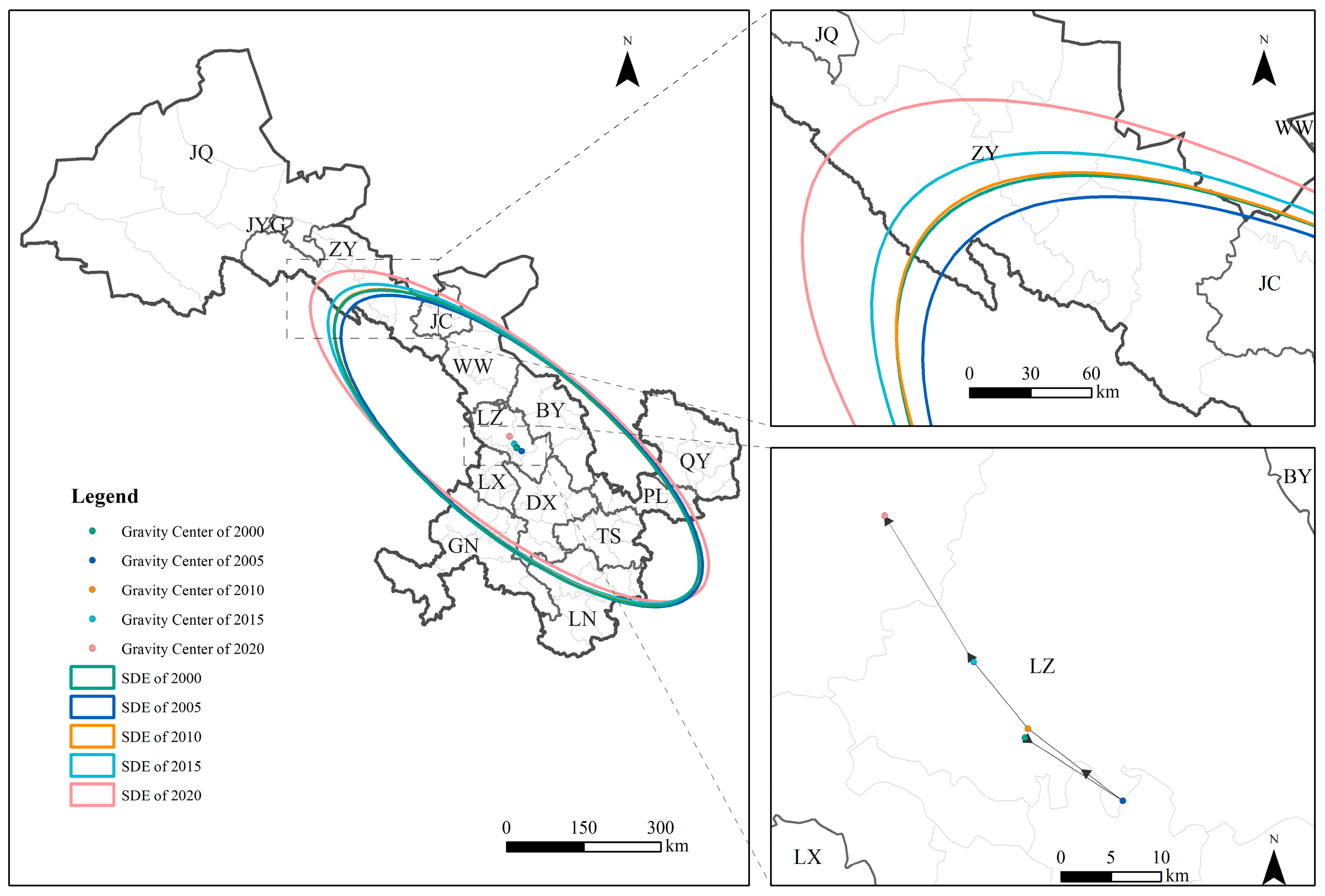
| Data (Unit) | Spatial Resolution | Temporal Resolution | Source |
|---|---|---|---|
| DEM (m) | 90 m | -- | Geospatial Data Cloud (https://www.gscloud.cn/, accessed on 8 June 2024) |
| Land use (Unitless) | 30 m | 1 year | Data Center for Resource and Environmental Sciences, Chinese Academy of Sciences (https://www.resdc.cn/, accessed on 8 June 2024) |
| PM2.5 (µg/m3) | 0.01° | 1 month | China HighAirPollutants (CHAP) (https://data.tpdc.ac.cn/, accessed on 10 July 2024) |
| Population (person) | 30 arcsec | 1 year | LandScan Global Vital Statistics Database (https://landscan.ornl.gov/, accessed on 10 July 2024) |
| Land Use Type | Period | Cropland | Forest | Grassland | Water | Construction Land | Unused Land |
|---|---|---|---|---|---|---|---|
| Cropland | 2000–2005 | 63,828 | 246 | 1226 | 11 | 181 | 50 |
| 2005–2010 | 61,990 | 316 | 2319 | 46 | 488 | 244 | |
| 2010–2015 | 63,872 | 50 | 656 | 26 | 295 | 51 | |
| 2015–2020 | 59,696 | 306 | 3580 | 94 | 651 | 471 | |
| 2000–2020 | 57,982 | 702 | 5168 | 115 | 1353 | 222 | |
| Forest | 2000–2005 | 84 | 37,430 | 143 | 4 | 15 | 6 |
| 2005–2010 | 163 | 37,648 | 271 | 17 | 17 | 83 | |
| 2010–2015 | 73 | 38,275 | 222 | 4 | 7 | 11 | |
| 2015–2020 | 251 | 37,073 | 1125 | 23 | 49 | 68 | |
| 2000–2020 | 330 | 36,067 | 1070 | 32 | 69 | 114 | |
| Grassland | 2000–2005 | 766 | 497 | 141,298 | 8 | 37 | 100 |
| 2005–2010 | 1711 | 535 | 139,122 | 65 | 97 | 1506 | |
| 2010–2015 | 624 | 245 | 141,969 | 27 | 81 | 195 | |
| 2015–2020 | 2878 | 1071 | 137,098 | 88 | 316 | 1630 | |
| 2000–2020 | 3437 | 1652 | 135,347 | 119 | 435 | 1716 | |
| Water | 2000–2005 | 16 | 3 | 30 | 3253 | 2 | 36 |
| 2005–2010 | 53 | 9 | 32 | 3125 | 4 | 105 | |
| 2010–2015 | 11 | 2 | 13 | 3423 | 4 | 126 | |
| 2015–2020 | 58 | 14 | 96 | 3268 | 15 | 113 | |
| 2000–2020 | 75 | 9 | 88 | 3045 | 22 | 101 | |
| Construction land | 2000–2005 | 15 | 2 | 8 | 0 | 3510 | 0 |
| 2005–2010 | 230 | 8 | 38 | 1 | 3473 | 27 | |
| 2010–2015 | 38 | 2 | 16 | 0 | 4182 | 1 | |
| 2015–2020 | 377 | 19 | 129 | 12 | 4041 | 98 | |
| 2000–2020 | 353 | 15 | 71 | 10 | 3076 | 10 | |
| Unused land | 2000–2005 | 694 | 21 | 331 | 52 | 32 | 171,474 |
| 2005–2010 | 803 | 76 | 1359 | 325 | 160 | 168,943 | |
| 2010–2015 | 180 | 15 | 205 | 84 | 107 | 170,317 | |
| 2015–2020 | 553 | 115 | 1735 | 411 | 390 | 167,497 | |
| 2000–2020 | 1636 | 153 | 2019 | 575 | 507 | 167,714 |
| Period | Cropland | Forest | Grassland | Water | Construction Land | Unused Land | Integrated * |
|---|---|---|---|---|---|---|---|
| 2000–2005 | −0.042% | 0.274% | 0.046% | −0.072% | 1.369% | −0.109% | 0.109% |
| 2005–2010 | −0.139% | 0.206% | 0.015% | 1.508% | 2.446% | −0.088% | 0.261% |
| 2010–2015 | −0.047% | −0.002% | −0.008% | −0.084% | 2.062% | −0.024% | 0.079% |
| 2015–2020 | −0.304% | 0.005% | 0.095% | 1.863% | 3.362% | −0.097% | 0.393% |
| 2000–2020 | −0.132% | 0.122% | 0.037% | 0.832% | 2.726% | −0.079% | 0.130% |
| China Ambient Air Quality Standards (GB 3095–2012) | WHO Global Air Quality Guidelines (2021) | ||||
|---|---|---|---|---|---|
| Concentration Limit Value | Concentration Limit Value | Interim Targets 1 | Interim Targets 2 | Interim Targets 3 | |
| Annual mean | 35 | 5 | 35 | 25 | 15 |
| Daily average | 75 | 15 | 75 | 50 | 37.5 |
| Year | Cropland | Forest | Grassland | Construction Land | ||||
|---|---|---|---|---|---|---|---|---|
| p Value | Moran’s I | p Value | Moran’s I | p Value | Moran’s I | p Value | Moran’s I | |
| 2000 | 0.000 | 0.778 | 0.000 | 0.796 | 0.000 | 0.798 | 0.000 | 0.709 |
| 2005 | 0.000 | 0.765 | 0.000 | 0.787 | 0.000 | 0.775 | 0.000 | 0.736 |
| 2010 | 0.000 | 0.785 | 0.000 | 0.787 | 0.000 | 0.775 | 0.000 | 0.735 |
| 2015 | 0.000 | 0.816 | 0.000 | 0.798 | 0.000 | 0.834 | 0.000 | 0.731 |
| 2020 | 0.000 | 0.725 | 0.000 | 0.620 | 0.000 | 0.606 | 0.000 | 0.644 |
| Land-Use Type | Year | Long Half-Axis/km | Short Half-Axis/km | The Coordinate of Gravity Center | The Shift of Gravity Center | ||||
|---|---|---|---|---|---|---|---|---|---|
| Orientation/° | Center X/° | Center Y/° | Direction | Distance /km | Velocity /km·a−1 | ||||
| Cropland | 2000 | 438.151 | 165.971 | 129.276 | 103.723 | 36.186 | - | - | |
| 2005 | 432.826 | 165.465 | 129.065 | 103.836 | 36.131 | 328.888 | 11.628 | 2.326 | |
| 2010 | 439.342 | 164.471 | 129.336 | 103.725 | 36.194 | 144.456 | 11.899 | 2.380 | |
| 2015 | 446.793 | 165.399 | 129.069 | 103.661 | 36.252 | 131.237 | 8.595 | 1.719 | |
| 2020 | 475.821 | 164.213 | 128.133 | 103.55 | 36.379 | 123.127 | 17.046 | 3.410 | |
| Forest | 2000 | 436.713 | 164.747 | 129.434 | 103.720 | 36.201 | - | - | |
| 2005 | 432.754 | 164.618 | 129.053 | 103.824 | 36.147 | 327.436 | 10.913 | 2.183 | |
| 2010 | 439.401 | 163.324 | 129.283 | 103.717 | 36.214 | 141.682 | 11.975 | 2.395 | |
| 2015 | 447.299 | 164.427 | 129.114 | 103.653 | 36.274 | 129.962 | 8.707 | 1.741 | |
| 2020 | 474.051 | 163.858 | 128.212 | 103.568 | 36.382 | 120.304 | 13.987 | 2.797 | |
| Grassland | 2000 | 436.713 | 164.747 | 129.434 | 103.720 | 36.201 | - | - | |
| 2005 | 432.754 | 164.618 | 129.053 | 103.824 | 36.147 | 327.436 | 10.913 | 2.183 | |
| 2010 | 439.401 | 163.324 | 129.283 | 103.717 | 36.214 | 141.682 | 11.975 | 2.395 | |
| 2015 | 447.299 | 164.427 | 129.114 | 103.653 | 36.274 | 129.962 | 8.707 | 1.741 | |
| 2020 | 474.051 | 163.858 | 128.212 | 103.568 | 36.382 | 120.304 | 13.987 | 2.797 | |
| Construct-ion land | 2000 | 439.237 | 165.156 | 129.311 | 103.721 | 36.191 | - | - | |
| 2005 | 433.020 | 164.999 | 129.087 | 103.840 | 36.133 | 328.467 | 12.199 | 2.440 | |
| 2010 | 438.476 | 163.818 | 129.417 | 103.739 | 36.185 | 147.344 | 10.498 | 2.100 | |
| 2015 | 443.094 | 165.085 | 129.324 | 103.686 | 36.232 | 131.015 | 7.036 | 1.407 | |
| 2020 | 469.764 | 163.325 | 128.397 | 103.594 | 36.359 | 118.350 | 16.242 | 3.248 | |
Disclaimer/Publisher’s Note: The statements, opinions and data contained in all publications are solely those of the individual author(s) and contributor(s) and not of MDPI and/or the editor(s). MDPI and/or the editor(s) disclaim responsibility for any injury to people or property resulting from any ideas, methods, instructions or products referred to in the content. |
© 2025 by the authors. Licensee MDPI, Basel, Switzerland. This article is an open access article distributed under the terms and conditions of the Creative Commons Attribution (CC BY) license (https://creativecommons.org/licenses/by/4.0/).
Share and Cite
Liu, F.; Jia, S.; Ma, L.; Lu, S. Spatiotemporal Dynamic Evolution of PM2.5 Exposure from Land Use Changes: A Case Study of Gansu Province, China. Land 2025, 14, 795. https://doi.org/10.3390/land14040795
Liu F, Jia S, Ma L, Lu S. Spatiotemporal Dynamic Evolution of PM2.5 Exposure from Land Use Changes: A Case Study of Gansu Province, China. Land. 2025; 14(4):795. https://doi.org/10.3390/land14040795
Chicago/Turabian StyleLiu, Fang, Shanghui Jia, Lingfei Ma, and Shijun Lu. 2025. "Spatiotemporal Dynamic Evolution of PM2.5 Exposure from Land Use Changes: A Case Study of Gansu Province, China" Land 14, no. 4: 795. https://doi.org/10.3390/land14040795
APA StyleLiu, F., Jia, S., Ma, L., & Lu, S. (2025). Spatiotemporal Dynamic Evolution of PM2.5 Exposure from Land Use Changes: A Case Study of Gansu Province, China. Land, 14(4), 795. https://doi.org/10.3390/land14040795





